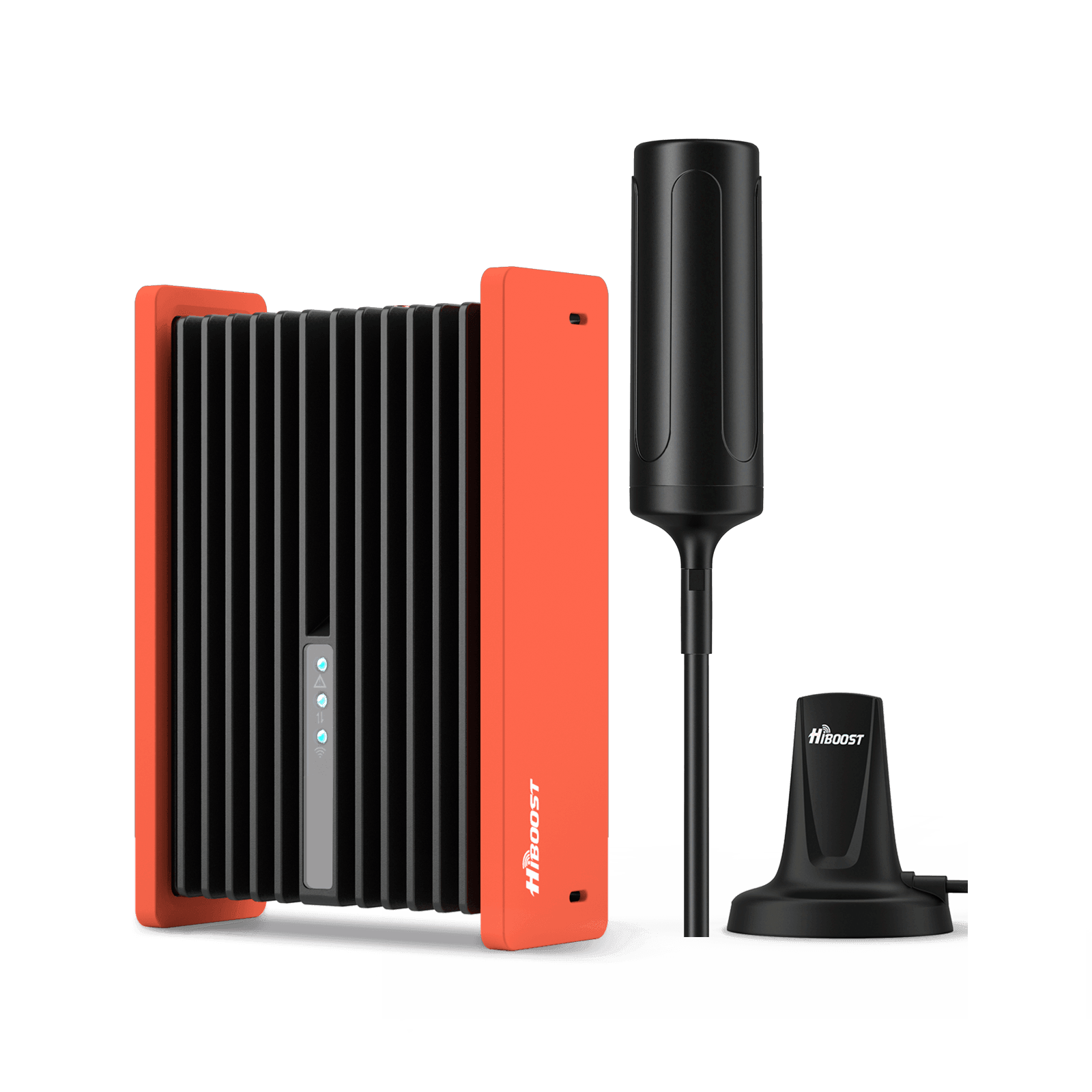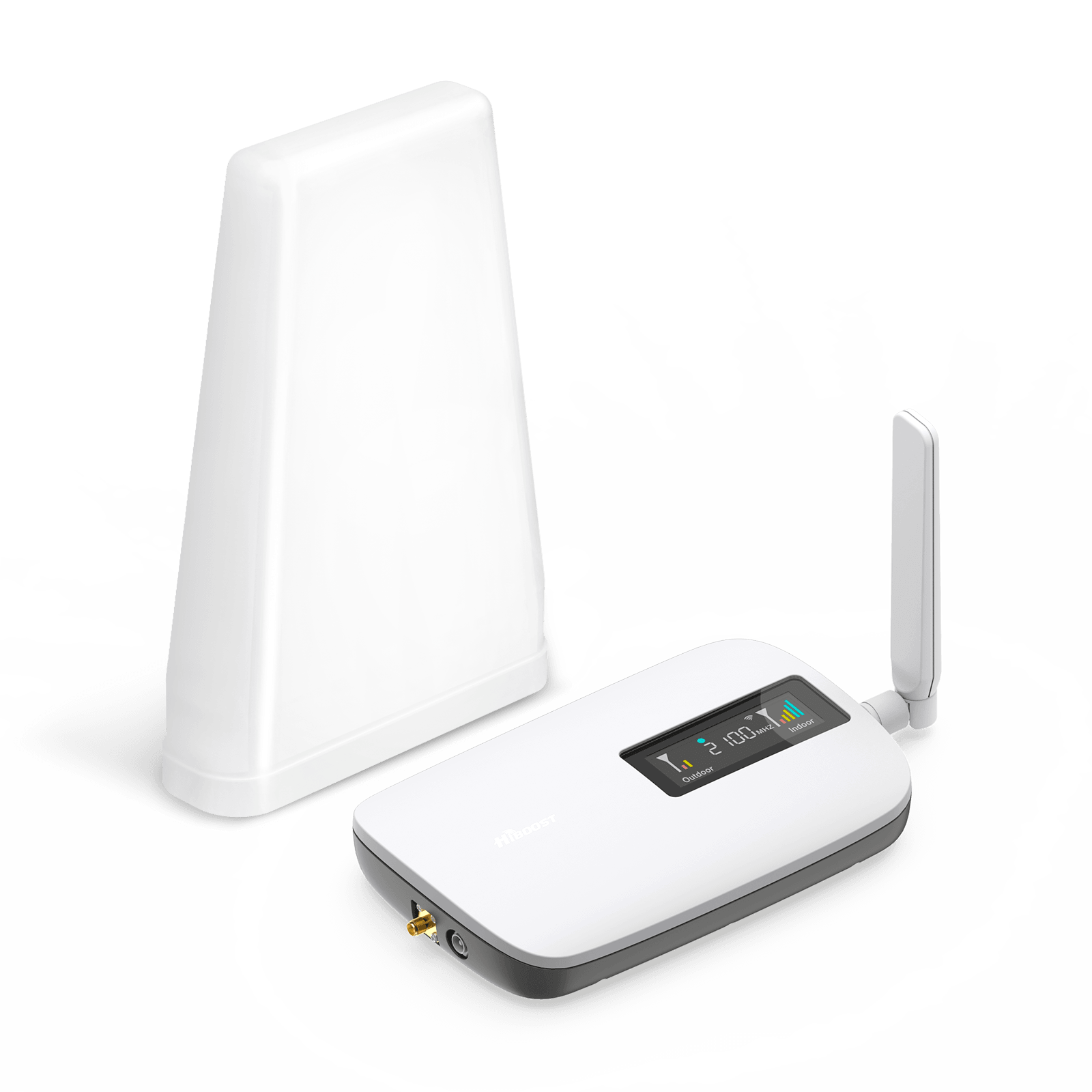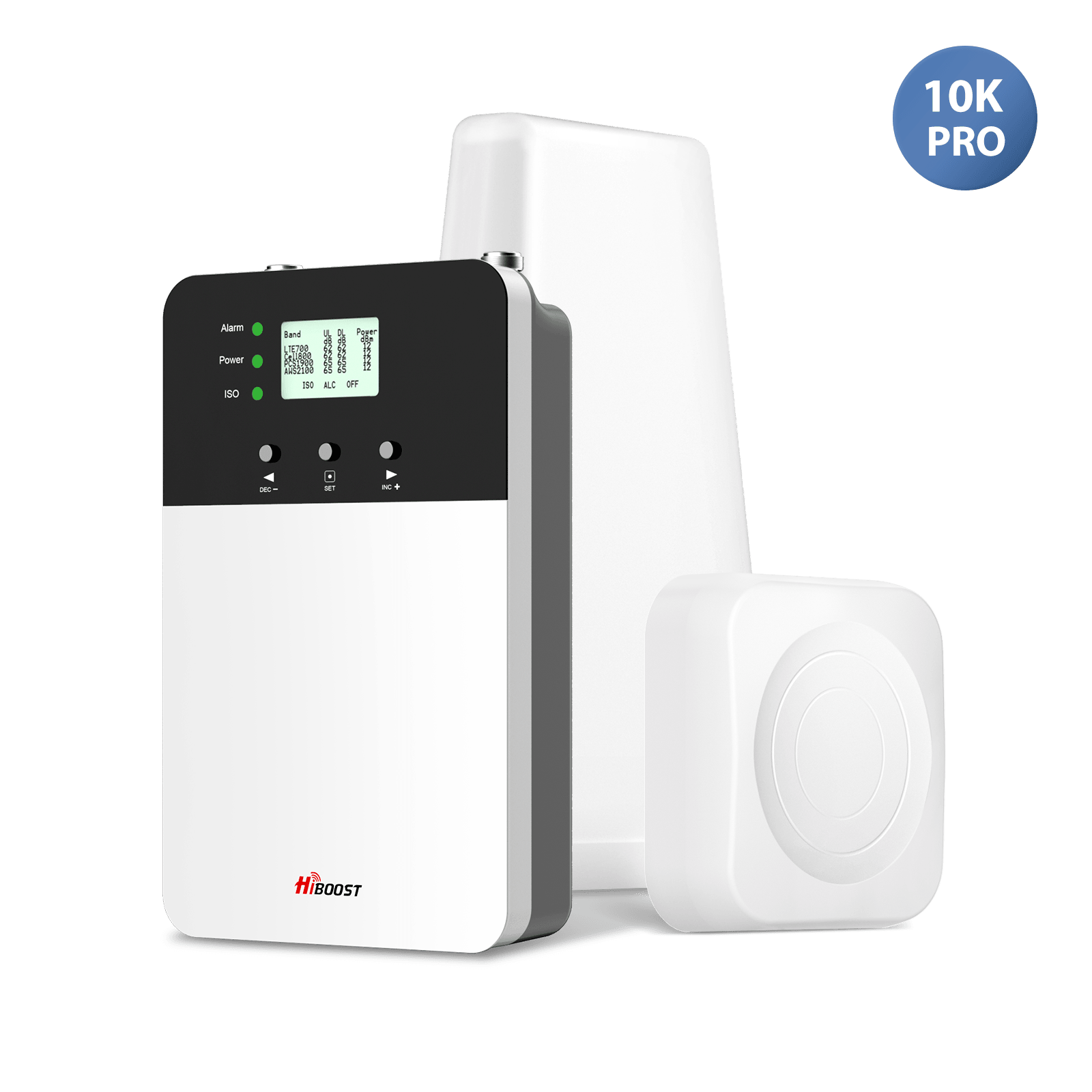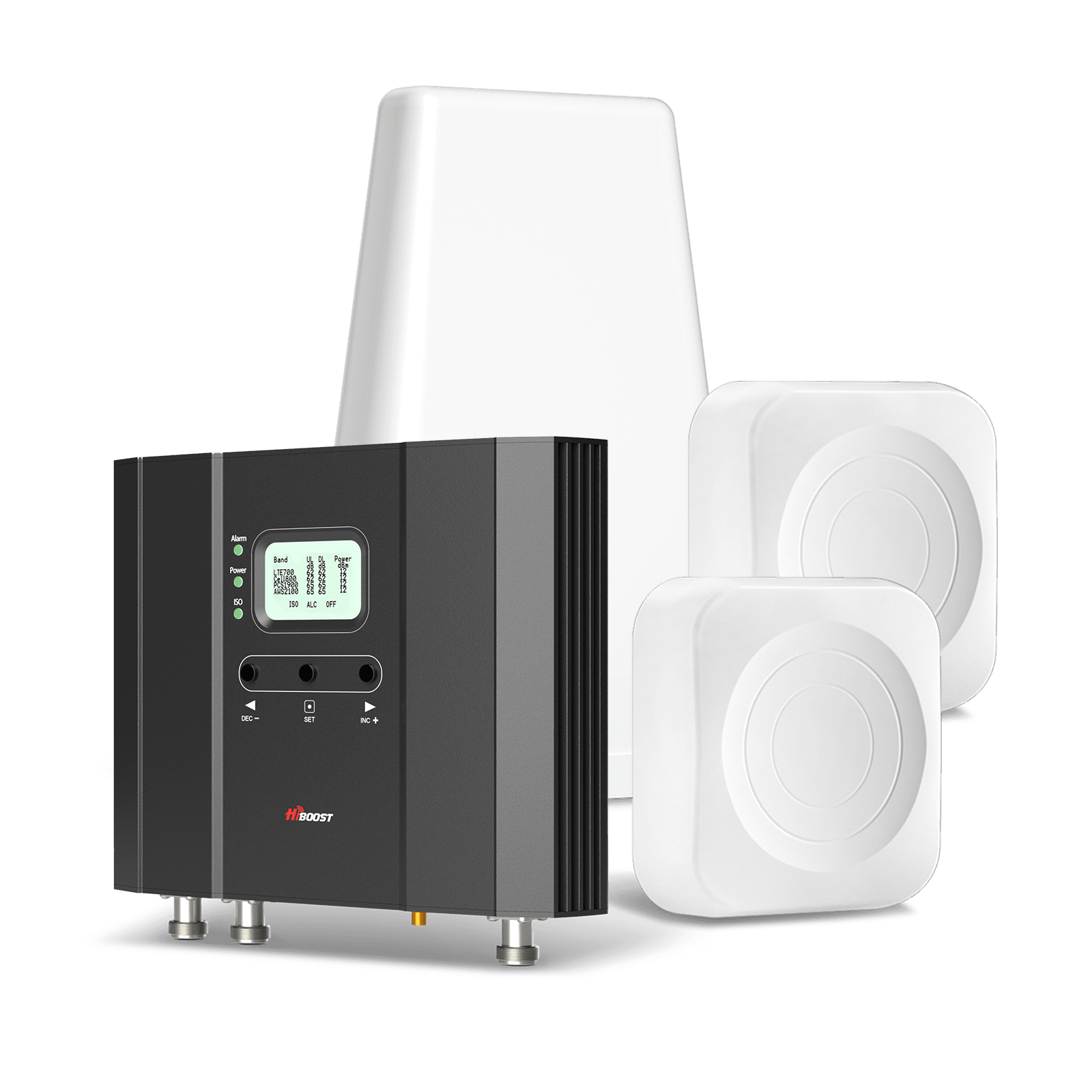If you have ever experienced unreliable cell service, a cell phone signal booster kit is an effective way for you to stop the dropped calls and increase the data speeds. The equipment can eliminate the aggravations of any phone and other cellular-connected devices users who already have existing signals outside their homes, offices, or vehicles.

There are hundreds of different mobile signal boosters on the market. It’s hard to choose the best cell phone booster that works for you. Applications vary based on the signal strength outside your homes, the size of your home, numbers on walls, different carriers, numbers of users, devices, and price. Therefore, it’s essential to get to know what you really need and which to buy before purchase.
This is why we write this guide. It includes everything you need to know before deciding which unit works for you. Please feel free to contact us if you have any questions. Keep in mind that your mobile booster manufacturer should be FCC certified and offer warranties and a money-back guarantee. Hiboost, as an industry-leading manufacturer which has improved cell service for more than 100,000 families in the United States, all its cell signal boosters are FCC-Approved and provide every customer with lifetime US-Based technical support, a 3-year warranty, and a 30-day money-back guarantee.
Get to Know Cell Phone Booster
What is a Cell Phone Signal Booster?
Mobile phone signal booster is also called cellular repeaters, signal amplifiers, and cell phone network extenders. They boost 2G,3G, and 4G LTE cell signals on all major North American carriers and all cellular devices. A cell signal booster kit works by capturing a signal outside your building via the outdoor antenna and rebroadcasting the signal amplified by the booster via the indoor antenna. If you have a usable signal outside your building, then congratulations! A cellular signal booster kit will work for you. Mobile cell phone boosters work has no monthly subscription and no recurring fees. There is no Wi-Fi connection needed. They work with all phones and support all carriers. They effectively eliminate dropped calls and slow data for internet connectivity, improving cell reception for spaces from 200 – 20,000 sq ft.
Top Benefits of a Cell Phone Signal Booster

Why You Have Unreliable Cell Service
The main reason for unreliable cellular service is weak cell phone signal which results from various kinds of factors working together or independently. The primary culprits to be blamed for weak signals are listed below.
Cell Tower Distance — The farther you’re from the nearest cell tower, the weaker the signal you will receive on your phone. This happens more frequently in remote and rural areas.
Mother Nature–Mountains, hills, rocks, trees, leaves, winds, rain, snowfall are good signal blockers between you and the cell tower that weaken the signal.
Building Materials– As cell signals can not travel through materials like concrete, metal or safety glass, these man-made materials also do an excellent job in preventing pulling the signal into the building and vehicles.
How A Mobile Phone Booster Work

A cell phone signal booster works by capturing the existing outside signal with its exterior antenna. The outdoor antenna transmits the signal to the cellular booster. The booster then amplifies the signal and rebroadcasts it through the interior antenna. Correct installation of these components is essential before you enjoy boosted signal for better call quality and faster data speed. Cell phone signal amplifier kit can improve signal for small to large-sized homes, offices, commercial buildings, apartments as well as vehicles including cars, SUVs, trucks and RVs.
A signal booster kit includes three main components with cables to connect each other, which are:
Outdoor antenna: communicates with the cellular tower, captures the signal from the tower, and sends it to the signal booster unit inside the building. It’s usually installed in the exterior of the building where has the strongest signal from the nearest cell phone signal.
Signal booster: receives and amplifies the signal and transmits it to the indoor antenna.
Indoor antenna: rebroadcasts the amplified signal throughout the place that needs cellular reception.
Vehicle Cell Phone Booster for Car, SUV, Truck, or RV
Vehicles cellular amplifiers or mobile signal boosters are designed to boost cell signal within the cabin of cars, sedans, trucks, vans, SUVs, RVs, trailers, and campers. These booster kits are smaller and much easier to install.
All of Hiboost vehicles booster support multiple users and devices as well as work with all US carriers including Verizon, AT&T, T-mobile, US-Cellular Sprint, Rogers, and any other North American carriers.
The travel 4G 2.0 is available as a kit for a passenger car, sedan, and SUVs. The Travel 4G 2.0 RV is a multi-user Rv cell phone booster that amplifies cell signals for RVs as well as trailers and campers. The Travel 4G 2.0 OTW is the best cell phone booster for trucks, semi-trucks, and SUVs.
Cell phone signal boosters for home or office are designed to improve indoor cell signal reception within space ranging from one room to an entire house. All of Hiboost home cellular amplifiers are compatible with multiple users and phones or any other cellular-connected devices at the same time. Most of them support all North American carrier’s networks.
Cell Phone Booster for a Small Home or Office
A cell signal booster for home and office allows you to enjoy hassle-free communication and an uninterrupted network connection. You won’t need to go outside or stand by a window to search for a signal. Scroll down to check out the best cell phone booster for home!
Hiboost 4K Smart Link signal amplifier kit is our most classic and reliable cell signal and network solution for small homes. The cell phone repeater is featured with a max gain of 60 dB, which is sufficient to cover a small size home and supports multiple users and devices at the same times. This all-carrier signal booster amplifies 4G LTE signal in a space up to 4,000 sq ft. (with perfect outside signal)
If you’re looking for a cell signal and network solution with a limited budget, then the Hiboost 4K Smart Link cell booster kit is a great option for you.

Cell Phone Booster for a Medium Home or Office
If you have a midsize home or office with a square footage of 4,000 with poor outside signal, Hiboost 10K Smart Link is the best cell service booster kit for you.
This all-carrier and multi-user booster is featured with a yagi directional antenna and 10 dBm high downlink power, it can reach farther and provide more powerful cellular signal amplification. The installation is simpler with an LCD display and the Hiboost exclusive app. The LCD display also tells you whether it’s working well and allows troubleshooting straightforwards. It can also connected and remotely monitor via Hiboost Signal Supervisor App.
Cell Phone Booster for a Large Home or Office
The 15K Smart Link is our most powerful cell phone booster kit for a large home or office.
If you just have one bar of outside signal or have a large home or office with an area of 6,000 -10,00, the 15K Smart Link is recommended.
This cellular signal booster is designed with a max gain of 70 dB and output power of 12 dBm, it will be powerful enough to power multi indoor antennas. It’s our best cell phone booster for rural areas, which is a good option if your home or office has multi rooms or two floors.
If you’re covering a larger building, with space over 12,000 square feet, you may need a commercial booster. Please call us now at (972) 870-5666 or live chat with us for a free consultation, to choose the best cell booster for your case.

Cellular Signal Guide
2G, 3G, 4G LTE, and 5G?
2G: 2G is the second generation of mobile networks introduced in the early 1990s. In addition to voice calls, it enabled data transmissions for the first time. People are allowed to make and receive calls, send texts and pictures on their cell phones. In the United States, some carriers are already in the process of shutting down the 2G networks with the widespread use of 4G LTE and 5G growing
3G: 3G refer to the third generation of cellular networks, which provides increased bandwidth and delivers a remarkably faster data rate. With 3G telecommunication networks, the internet began to be widely used on mobile phones and smartphones not long after.
4G: 4G LTE stands for the fourth generation of cellular technology which delivers a much faster mobile internet experience than 3G. It allows activities that require a large amount of cell data such as streaming videos, browsing the web, online gaming, etc. 4G LTE is the current commercial cellular standard for voice and data worldwide.
5G: 5G represents the next generation of wireless network technology. But the definition for 5G is vague and not finalized yet. It will provide higher data speeds than 4G LTE,ultra-low latency for more broadband users. But it’s in development.
Signal Strength and Coverage
Signal strength outside your building or vehicles will have a major impact on the signal booster performance and coverage you’re going to receive from it.
If you have a stronger signal, you’re going to have extended cell coverage.
If the outside signal is weak, you’ll receive a small amount of cellular coverage from your signal booster. And you will need to purchase a more powerful amplifier.
Therefore, it’s important to know your signal strength before you decide which booster to purchase. Check out the next section to learn how to test cellular signal strength.
Understanding signal bars
Signal bars is an inaccurate measurement of signal strength. Though the numbers indicate the signal strength and signal quality you’re receiving on your cell phone, there is no industry standard yet. The signal bars vary from phone to phone even when you put them next to each other, as all carriers and phone manufacturers make up their own calculations.
How to measure your signal strength.
Decibel milliwatts or dBm is the standard unit of measurement to define signal strength in wire and cables at radio and audio frequencies. dBm is expressed as a negative number on a signal meter. The closer to 0 the number reading is, the stronger the signal strength.
Signal strengths generally range from -30 to -110 dBm. Generally, -50 dBm is considered to be excellent in signal strength level. Anything worse than -110 dBm is thought to be no signal or dead zone, and you’re unlikely to have cell service. In this case, installing a signal booster is not going to help as the equipment is used to boost the signal rather than create one. To use cell service on your phone, you’re supposed to have signal strength better than -85 dBm. If the signal at your place is not hitting this benchmark, you will need to get a signal amplifier.

You can use a website like “Antenna search “or an application like “OpenSignal” to get a reading of your signal strength. Besides, putting your phones in Field Test mode will indicate what level of decibels (dBm) your phone is currently receiving.
How to test signal strength with iOS 11.
Go to Settings / WiFi / Turn Off WiFi
Dial and call *3001#12345#* to enter the field test mode
Tap Serving Cell Measurements
Scroll down to Measured RSSI
How to test signal strength with other iOS versions.
Go to Settings / WiFi / Turn Off WiFi
For iOS 9.3 and later versions, go to 1.Settings > Cellular > Cellular Data Options > Enable LTE > Turn Off LTE.
For iOS 9.2 and earlier versions, go to Settings > Cellular > Enable LTE > Turn Off LTE
2. Dial and make a call to *3001#12345#*
Tap Serving Cell Measurements and refer to Measured RSSI
How to test signal strength with Android
Go to setting
Tap About Phone
Select Status or Network
Tap SIM Status
Your Signal Strength is read in dBm
Cellular Frequency Bands
The radio spectrum is divided up different sections called frequency bands and cellular service runs on these bands. FCC, the Federal Communications Commission licenses these bands to carriers who will use these bands exclusively.
There are mainly 4 frequency bands used by carriers in the United States. All Hiboost signal boosters work with these bands.
700 MHz band ( band 12, 13, and 17): Used by Verizon, AT&T, and T-Mobile, only for 4G LTE service.
850 MHz Band ( band 5): Used by AT&T and Verizon for a mix of 3G&4G service, Sprint for 4G service only.
1900 MHz “PCS Band” (band 2): Used by Verizon, AT&T, T-mobile, and T-Mobile for a mix of 2G, 3G & 4G LTE service.
2100 MHz “AWS Band” (band 4): Used by T-Mobile, AT&T, and Verizon for 4G LTE service only.
There are other frequency bands provided by the carriers but most signal boosters in the market do not support them.
Amplifier Specs: Gain and Downlink Power
Gain and Downlink Power are two specifications you need to pay attention to when you select a signal booster for your case.
Gain indicates the ability that a booster amplifies signals, measured in dB. The larger the gain value is, the more powerful the booster is, and the more the cell signal is amplified. Gain is expressed in a positive decibel/dB figure, measured on an algorithmic scale. 10dB gain is 10 times the existing signal strength while 20dB gain equates to 100 times more signal.
Downlink output power, measured in dBm, refers to the signal from a cell tower to a phone or other cellular devices in the building or vehicle, which will have an impact on the cell coverage of the boosted signal. The maximum downlink output power decides the maximum coverage area of the cellular amplifier when the amplifier has enough cell signal.
Cell Phone Signal Booster Terms
Radio frequency (RF)-Frequencies used to transmit wireless radio signals including cellular,, Wi-Fi, AM, and FM radio signals.
Downlink signal – the signal to a cellular device from a cell phone tower.
Uplink signal – the signal sent to a mobile tower tower from a cellular device
FCC -The short form for Federal Communications Commission, which regulates the use of cellular frequencies in the United States.
RSSI- Abbreviation of Received Signal Strength Indicator. It represents the power of signal strength that a cellular device is receiving from a cellular tower.
Oscillation– Oscillation, or feedbacks, happens when the boosted signal broadcasting from the interior antenna gets picked up by the exterior antenna and forced through the signal booster. It will result in interference, poor cellular reception, or the system will stop working.
Coaxial cable –A special type of cable used to transmit radio frequency signals including data, internet, and video. It’s made up of copper and aluminum conductors with shielding to help minimize signal loss.
Donor antenna – Used to receiving a signal from a cell phone tower, usually mounted outside a building or vehicle
Omni-directional antenna – An Omni-directional cell antenna catches and rebroadcasts signal from a 360-degree field.
Directional antenna – A directional antenna receive and transmit signal in a specific direction, from a 90-degree maximum field. This will enable a stronger signal to reach the signal amplifier.
Dome antenna – A dome antenna is typically mounted in the ceiling of a building, and rebroadcasts cell signals downwards.
Panel antenna – A kind of directional antenna, which is installed on a wall in the building.
Lightning surge protector – A device to protect your outdoor antenna in your signal booster system from lightning strikes.
FAQ
How outside signal strength affect booster performance?
The outside signal strength definitely has a great influence on the overall performance of the cell booster. The stronger the out signal, the more effective the booster will be at boosting the signal strength. Therefore, the outdoor antenna installation is the most essential part of the booster kit installation, which should be mounted in a place with the best outside signal.
How to find the best outside signal?
Point the Outside Antenna toward the nearest cell phone tower. To find the nearest cell tower, you can use a specialized website or App such as the app ‘Open Signal’ or website www.cellmapper.net.
How to find cell towers near me?
To find your cell tower, go to www.cellmapper.net and input your carrier and location. Use the map to find a tower that is facing your direction, even if it is farther away than a closer tower facing the wrong way. For the best results, point at a tower located within 10 miles of your outdoor antenna.
It’s not difficult to locate the closest cell tower from your building. You may use some helpful and easy-to-use online resources, such as specialized websites and apps.
Is it difficult to install the booster kit?
The homemade cell phone booster installation will take some time handiness as it includes a few steps. But each step is not difficult to handle.
Generally, the installation of vehicle signal boosters is easier and takes less time than the home boosters. It usually takes about 20 minutes to install.
A home booster might take longer for the installation, about 2 to 3 hours. It involves finding the strongest outside signal, mounting the outdoor antenna on or near the roof, running cable into the building, which is the most essential step which will decide the overall performance of the signal booster kit.
Hiboost Users Manual will provide detailed instructions to guide you with the process. Besides, Hiboost unique and exclusive app allows easier setup and monitoring to make the booster work at its best.
Feel free to contact our well-trained technicians at 972-870-5666 if you need any installation assistance.
Is a Wi-Fi connection needed to use a cell phone booster?
It does not need Wi-Fi or a landline connection.
Do cell phone boosters work?
Absolutely, as long as there is a usable signal outside your building or vehicles, the booster kit will be able to pull it in and amplify it, providing you the enhanced improved signal for better talk, text, faster data, and streaming.
What frequency bands does Hiboost cover?
Hiboost cellular boosters amplify the signal on all North American carrier networks and all smartphones, tablets, hotspots, or any other cellular-connected devices. The frequencies used range from 700 MHz to 2100 MHz, Band 12/17, Band 13, Band 5, Band 25/2, Band 4. You could go through the booster’s product page on the Hiboost website to check out the specific frequency bands used by your booster.
Can I use it as a hotspot for my laptop?
Sure, the booster kit amplifies 4G LTE voice and data for all cellular devices including the cellular hotspots. A stronger 4G LTE signal means a better internet connection for your Laptop.
Will a booster work in remote or rural areas?
Sure thing! Hiboost signal boosters work even in remote or rural areas. As long as you have a usable outside signal, the cellular booster kit will be able to reach the cell tower from far away, pull it in, and amplifies it for your home or vehicles.
Will it work with 5G?
All Hiboost cellular signal boosters are compatible with 5G phones.
5G is in development. There isn’t a 5G cell phone booster in the consumer market yet, regardless of manufacturers, even though you may have seen that carriers are promoting their 5G service. It won’t come out soon, at least in the next decade or more.
What we do on our phone or other cellular devices is feasible with 4G LTE effortlessly as long as cellular connectivity is strong and consistent. 5G is used to complement 4G, rather than replace it. 4G has more than ten years to go. Therefore, there is no need for a 5G mobile network booster for consumer applications.
Our family uses different carriers, will it work for us?
Yes, all Hiboost cell phone signal boosters amplify cell signals on major North American carriers’ networks and all cellular devices simultaneously. They cover frequencies between 700 MHz and 2100 MHz. You could view the specific frequency bands covered by a certain booster by going through the product page on our website.

![A Complete Guide to Cell Phone Signal Booster [2023] - Hiboost](http://www.hiboost.com/cdn/shop/articles/A_Complete_Guide_to_Cell_Phone_Signal_Booster.jpg?v=1725328997&width=1500)






Leave a comment
All comments are moderated before being published.
This site is protected by hCaptcha and the hCaptcha Privacy Policy and Terms of Service apply.